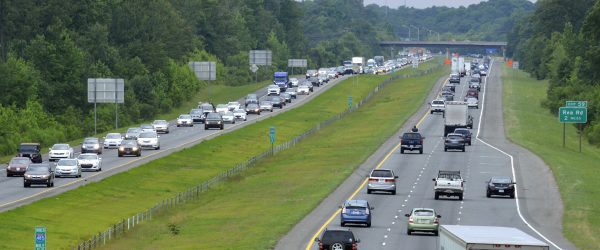Commuters: where they work and how they get there

More than 800,000 residents of the 32 counties studied as part of the UNC Charlotte Urban Institute’s Carolinas Urban-Rural Connections Project commute to work in a county other than the one in which they live—representing more than $32 billion of the region’s wages. According to researchers Bill Graves, Katie Zager and Laura Simmons, this is the most economically significant of all the environmental, cultural and economic factors that define the Charlotte region’s various communities.
Commuting patterns are tied in large part to the Charlotte region’s well-documented growth over the past two decades. Since 2002, as the regional population grew by 28 percent, out-of-county commuting increased nearly six times that rate. While most prevalent among the residents of the counties adjacent to Mecklenburg—as these areas rely on Charlotte as a source of employment more than ever before—more than 25 percent of those who live in the seven counties outside the Mecklenburg-adjacent ring work in another county.
Why are individuals commuting farther?
Growth aside, the loss of manufacturing jobs throughout the region has forced people to seek work farther from home, sometimes as far as 90 minutes away. The workers in this category—defined as super commuters—haven’t necessarily seen their wages increase and are forced to spend more of their income on fuel and vehicle maintenance, leaving less disposable income to spend locally. Furthermore, lengthy commutes limit super commuters’ time with family and the ability to volunteer near home.
Who travels the farthest?
Anonymous cell phone tracking data at select employment locations indicate that manufacturing firms are more likely than other businesses to employ workers from outside their home counties; it is this group that tends to have the longest commutes.
Conversely, people who work in small downtowns throughout the region live within eight miles of their jobs, allowing them to spend more time with their families and volunteer or lead in their communities. Another “winner” is the environment as less fuel is expended traveling to and from work.
Conclusion to solutions: Find ways for more people to work close to their homes
Overall, findings suggest (although sample sizes are too small to be definitively conclusive):
- Traditional economic development strategies, such as financial incentives for manufacturing firms to create jobs in rural areas, may not generate as much local employment as assumed
- New manufacturing jobs are as likely to go to workers in other counties as to local workers and contribute to a disproportionate share of long-distance commuting
- Efforts to expand employment opportunities in town centers are likely to have greater impact on local well-being than attracting new manufacturing facilities
- Jobs in small downtowns tend to find more local workers, retaining the social capital of the workforce and their incomes within the community
Related Stories
Finding the music: How one North Carolina city reinvented itself
Philanthropy: Can charitable giving foster greater regional connection?
 Since 1969, the UNC Charlotte Urban Institute has sought nonpartisan solutions to social, economic and environmental challenges facing communities in the Charlotte region through applied research and community outreach.
Since 1969, the UNC Charlotte Urban Institute has sought nonpartisan solutions to social, economic and environmental challenges facing communities in the Charlotte region through applied research and community outreach.
To mark its 50th year, the Urban Institute launches the Schul Forum Series on Nov. 21, which this year highlights findings from the Carolinas Urban-Rural Connections Project, a two-year research endeavor supported by the Duke Endowment aimed at identifying regional connections between urban and rural areas that can be strengthened to increase economic vitality.
As the inaugural forum approaches, Inside UNC Charlotte will share a preview of the project’s themes, outcomes and recommendations.


